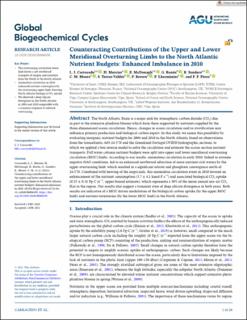| dc.contributor.author | Carracedo, Lidia I. | |
| dc.contributor.author | Mercier, Herlé | |
| dc.contributor.author | McDonagh, Elaine Louise | |
| dc.contributor.author | Rosón, G. | |
| dc.contributor.author | Sanders, Richard | |
| dc.contributor.author | Moore, C. Mark | |
| dc.contributor.author | Torres-Valdés, Sinhué | |
| dc.contributor.author | Brown, P. | |
| dc.contributor.author | Lherminier, Pascale | |
| dc.contributor.author | Pérez, F.F. | |
| dc.date.accessioned | 2022-03-24T09:41:30Z | |
| dc.date.available | 2022-03-24T09:41:30Z | |
| dc.date.created | 2022-01-25T14:54:00Z | |
| dc.date.issued | 2021 | |
| dc.identifier.issn | 0886-6236 | |
| dc.identifier.uri | https://hdl.handle.net/11250/2987262 | |
| dc.description.abstract | The North Atlantic Basin is a major sink for atmospheric carbon dioxide (CO2) due in part to the extensive plankton blooms which form there supported by nutrients supplied by the three-dimensional ocean circulation. Hence, changes in ocean circulation and/or stratification may influence primary production and biological carbon export. In this study, we assess this possibility by evaluating inorganic nutrient budgets for 2004 and 2010 in the North Atlantic based on observations from the transatlantic A05-24.5°N and the Greenland-Portugal OVIDE hydrographic sections, to which we applied a box inverse model to solve the circulation and estimate the across-section nutrient transports. Full water column nutrient budgets were split into upper and lower meridional overturning circulation (MOC) limbs. According to our results, anomalous circulation in early 2010, linked to extreme negative NAO conditions, led to an enhanced northward advection of more nutrient-rich waters by the upper overturning limb, which resulted in a significant nitrate and phosphate convergence north of 24.5°N. Combined with heaving of the isopycnals, this anomalous circulation event in 2010 favored an enhancement of the nutrient consumption (5.7 ± 4.1 kmol-P s−1) and associated biological CO2 uptake (0.25 ± 0.18 Pg-C yr−1, upper-bound estimate), which represents a 50% of the mean annual sea–air CO2 flux in the region. Our results also suggest a transient state of deep silicate divergence in both years. Both results are indicative of a MOC-driven modulation of the biological carbon uptake (by the upper MOC limb) and nutrient inventories (by the lower MOC limb) in the North Atlantic. | en_US |
| dc.language.iso | eng | en_US |
| dc.rights | Attribution-NonCommercial-NoDerivatives 4.0 Internasjonal | * |
| dc.rights.uri | http://creativecommons.org/licenses/by-nc-nd/4.0/deed.no | * |
| dc.title | Counteracting Contributions of the Upper and Lower Meridional Overturning Limbs to the North Atlantic Nutrient Budgets: Enhanced Imbalance in 2010 | en_US |
| dc.type | Peer reviewed | en_US |
| dc.type | Journal article | en_US |
| dc.rights.holder | © The Authors, 2021 | en_US |
| dc.description.version | publishedVersion | en_US |
| cristin.ispublished | true | |
| cristin.fulltext | original | |
| cristin.qualitycode | 2 | |
| dc.identifier.doi | 10.1029/2020GB006898 | |
| dc.identifier.cristin | 1989660 | |
| dc.source.journal | Global Biogeochemical Cycles | en_US |
| dc.source.volume | 35 | en_US |
| dc.source.issue | 6 | en_US |
| dc.relation.project | EC/H2020/727852 | en_US |
| dc.relation.project | EC/H2020/817578 | en_US |
| dc.relation.project | EC/H2020/820989 | en_US |
| dc.relation.project | Natural Environment Research Council: NE/M005046/1 | en_US |

